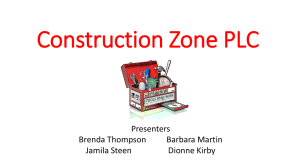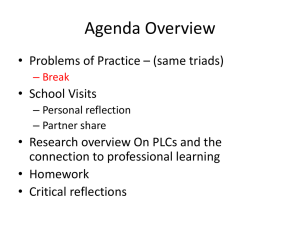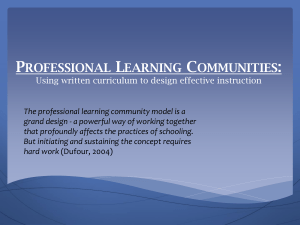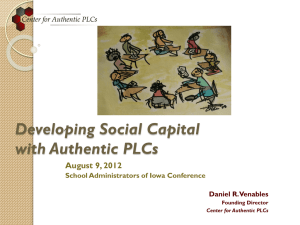CardellPLCPresentation
advertisement
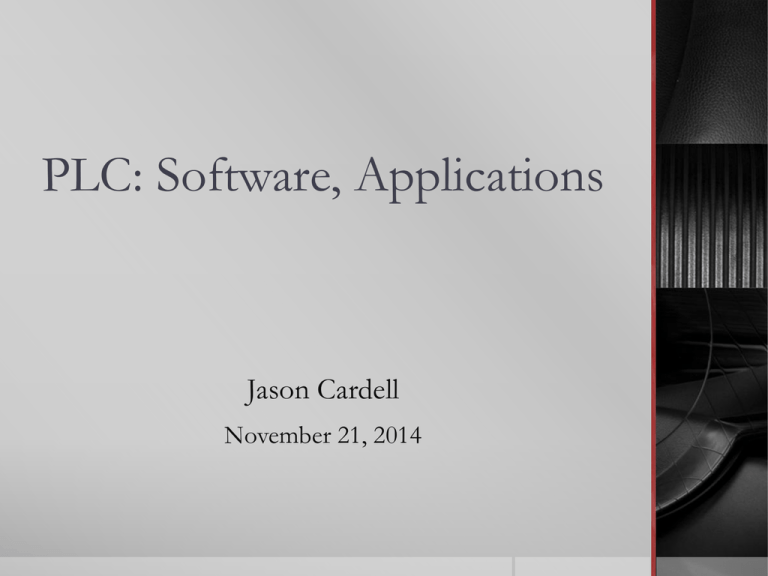
PLC: Software, Applications Jason Cardell November 21, 2014 Overview What is a PLC? “A Programmable Logic Controller (PLC) is an industrial computer control system that continuously monitors the state of input devices and makes decisions based upon a custom program to control the state of output devices.”(AMCI) Overview: History and Current State Prior to PLCs, industrial control systems were designed using relays, cam timers, drum sequencers, and dedicated closed loop controllers. Such control systems required a significant amount of space and were expensive to design, maintain, and update. The first PLC was designed and sold By Modicon (MOdular DIgital CONtroller) in 1977. (Wikipedia) The first PLC, model 084, was invented by Dick Morley (AMCI) in response to a need for more flexible control systems in the automotive industry. As car designs evolved, manufacturing control needed to evolve. Overview: Current State - Software PLCs are generally programmed using PC based software packages. Once a control system has been designed in the software application and compiled, the program can then be transferred to the PLC’s onboard non-volatile memory. PLC manufactures typically have a proprietary software package that communicates with their designed hardware. For example, if you are using an Allen-Bradely PLC then you will be required to use a compatible version of RSLOGIX to communicate with it. Although each PLC manufacturer designs their own software as a programming GUI, PLC language standards have been established (IEC 61131) and are strictly adhered to in industry. All PLC software packages can be used to program in the 5 basic PLC languages that will be covered later in this power point. Overview: Current State – Software Packages Overview: Current State - Languages Ladder Logic (LD)-Traditional ladder logic is a graphical programming language. Initially programmed with simple contacts that simulated the opening and closing of relays, Ladder Logic programming has been expanded to include such functions as counters, timers, shift registers, and math operations (AMCI). Ladder Logic is the most commonly used PLC programming language in industry. Ladder Logic uses a digital version of relay logic and thus relay circuits could easily be converted to this digital form. Overview: Current State - Languages If (SW1 OR SW2) and OVR1 =1, THEN START =1 Switch 1 (NOC) Override 1 (NOC) Start Bit(Coil) Subtract (FB) SPEED = X65 – 1 X54 = 1 Pump1 (NOC) Enable (NOC) Output 100 (output coil) %Q designates that %Q100 Is a physical output from PLC Overview: Current State - Languages Ladder Logic (LD)- Click (PLC Software for our LAB) Overview: Current State - Languages Ladder Logic (LD) – Every programs Ladder diagramming looks a little different. Tri-PLC has combined LD with higher Languages such as C++. Overview: Current State - Languages Function Block Diagram (FBD) - A graphical language for depicting signal and data flows through re-usable function blocks. FBDs are very useful for expressing the interconnection of control system algorithms and logic.(AMCI). Function Block Diagrams are often coupled with Ladder Logic to increase readability and improve diagnostic efficiency. Overview: Current State - Languages Structured Text (ST) – A high level text language that encourages structured programming. It has a language structure (syntax) that strongly resembles PASCAL and supports a wide range of standard functions and operators (AMCI). Some software packages allow programming in higher languages such as C++. Structured Text offers easy access to and manipulation of Ints, Dints, Reals, and Strings. Although this same code could be programmed in LD or one of the other languages, implementation is simpler and more compact in ST. Overview: Current State - Languages Instruction List (IL): A low level “assembler like” language that is based on similar instructions list languages found in a wide range of today’s PLCs (AMCI). Overview: Current State - Languages Sequential Function Chart (SFC) A method of programming complex control systems at a more highly structured level. A SFC program is an overview of the control system, in which the basic building blocks are entire program files. Each program file is created using one of the other types of programming languages. The SFC approach coordinates large, complicated programming tasks into smaller, more manageable tasks. Overview: Where Used? Modern theme parks are riddled with PLCs that constantly monitor rides, such as roller coasters, to ensure the safety of passengers and warn of possible failures before catastrophe strikes. . Overview: Where Used? Automated manufacturing lines predominately use PLCs to manage their machine controls. PLCs offer a quick flexible environment for Automation Engineers to design in. AS/RS control systems are often implemented using PLC based controls. Asynchronous control systems in industry typically use PLCs to interpret input devices and control output devices based on the given inputs. In many PLC applications, a combination of asynchronous and synchronous controls are used. Overview: Where Used? PLCs offer power plants the ability to constantly monitor dangerous systems remotely and provide maintenance workers with advanced diagnostic capabilities. Water treatment facilities rely on the dependability and repeatability offered by PLC based control systems. PLCs monitor and control pneumatic valves, pipe pressures, and flow rates via field bus communication networks. Overview: When Used? PLCs are used in virtually every industry and are the major means of controlling any industrial grade automated system. PLCs are used when a flexible control system is needed that can be easily updated to incorporate future technologies and accessed by maintenance workers for ease of troubleshooting. Overview: Cost per license Software TwinCat3 Rslogix 500 GX Developer Simatic Step 7 Rslogix 5000 CX-Programmer Unity Manufacturer Beckhoff Allen-Bradley Mitsubishi Siemens Allen-Bradley Omron Modicon Cost (Low) Cost (High) $0.00 $700 $500.00 $2,800.00 $600.00 $750.00 $5,500.00 $800.00 $7,000.00 $2,500.00 $4,000.00 $5,000.00 *The five basic PLC programming languages outlined in Standard IEC 61131 are available in any of the above mention software packages. Namely: IL, ST, FBD, LD, SFC. Overview: Supporting Technologies Sensors, Switches PLC Software Light Curtains / Safety Devices Digital / Analog I-O Blocks Network PLC Hardware Encoders, Actuators, Contacts References Application Rules & Limitations (IEC 61131) IEC (International Electrotechnical Commission) 61131-1: General information IEC 61131-2: Equipment test requirements IEC 61131-3 is the international standard for programmable controller programming languages. As such, it specifies the syntax, semantics and display for the following suite of PLC programming languages: (Rockwell Automation) Ladder diagram (LD) Sequential Function Charts (SFC) Function Block Diagram (FBD) Structured Text (ST) Instruction List (IL) IEC 61131-4: User guidelines IEC 61131-5: Communications Application Limitations Cost is one of the largest limitations in PLC use. In order to implement a robust control system using a PLC you need PLC hardware, PLC software, an array of sensors, switches, contacts, safety devices, etc. and a great deal of programming design work. Time limitations often play an important role in control system design. Building a robust PLC based control system requires a great deal of upfront programming time. However, when a flexible robust control system is needed, PLCs are worth the investment of time. Hardware Compatibility: Some control systems require hardware that communicates best with a PC. PLCs can be inefficient at communicating with and controlling hardware meant for a pc interface. Specific subsystem hardware may limit the control you have from a PLC and may require a PC type control or a hybrid control system that uses a PLC and PC. Primary Vendors of Technology How Automation Integrates Process Wherever you mix automation devices, you often use PLC to manage the asynchronous (event) state between the devices. Application Article Summary Advantages to PLC use over other industrial control systems Flexible and can be redesigned to control other systems quickly and easily. Computational abilities allow more sophisticated control. Trouble shooting aids make programming easier and reduce downtime. Early PLCs Early PLCs were programmed using proprietary programming panels and offered only Ladder Logic as the programming language with simple coils and contacts. PLCs vs. PCs Modern PLCs are approximately equivalent to desktop computers but run on more stable operating systems with control hardware that is more robust. PCs are generally not accepted in heavy industry due to hardware that has lacking levels of tolerance to temperature, humidity, vibration, and longevity in comparison to PLC hardware. PLRs (Programmable Logic Relays) are cheap versions of PLCs with reduced reliability and capability. Application Article Summary The following topics are covered in more detail in the article A history of PLCs. PLCs where created in response to a call for more flexibility from the automotive industry. Scan time estimations of PLCs A comparison between PLCs and other control systems Digital/analog signal handling Overview of Ladder Logic and reasons for its use Application Example Design a PLC based control system, using a combination of two or more languages, outlined in IEC 61131-3, that will flash at least one LED light at two different rates based on no more than two inputs to the PLC. You are limited to two PLC inputs and two PLC outputs. Solution – Ladder Logic (LD) Solution – Structured Text (ST) Solution – Structured Text (ST) Summary PLCs continuously monitor inputs and control outputs based on program logic and input values. PLCs were designed in response to a need for more flexible control systems in the automotive industry. As cars evolved, there was a need for the manufacturing control system to evolve. The five standard PLC languages are: Ladder Logic(LD), Function Block Diagram (FBD), Structured Text(ST), Instruction List(IL), and Sequential Function Chart (SFC). PLCs are used in every industry and are the primary means of control for asynchronous systems. The cost of PLCs and PLC software packages varies greatly based on vendor and licenses needed. Although all software packages offer the five basic languages, some vendors offer built in function blocks, higher level programing (C++, Java, object oriented, etc.), and other features. PLC hardware requires specific proprietary PLC software in order to program. IEC 61131 defines PLC hardware and software standards. Major software / application limitations include: Cost, Time and Hardware compatibility Automation Examples https://www.youtube.com/watch?v=VpwkT2zV9H0 https://www.youtube.com/watch?v=8_lfxPI5ObM Additional References http://www.newark.com/omron-industrial-automation/cxoneal01cv4/cx-onesoftware-package-version/dp/74R6893

